Layers
Content available at:
Español (Spanish)
What starts out as a fertile egg on the breeder farm must end up as a healthy chick on the broiler farm. After the hen lays the egg, its quality can only worsen, it will never be the same, so we must pay attention to the flow chain between the laying of the hatching egg and the start of the incubation.
Most of the causes that can influence the variability in hatchability or quality losses of the chick are caused by inadequate management of the egg handling processes pre-incubation.
Layers
They are the starting point to start measuring and talking about the quality of the chick. Layers should be accessible, comfortable and clean. We must have at least one third of extra mats to be able to clean them periodically and renew them. The rate of laying on the floor must be reduced to the minimum possible, ideally at levels below 1%. In cases exceeding 3%, we must find the causes and solutions.
The nesting box and the ribbon will influence:
Broken, cracked, dirty eggs laid on the ground:
Layer Management
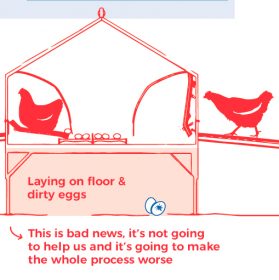
Lots of floor and dirty eggs produce “exploding eggs” and spread contamination in the incubator.
They also disperse contamination to the chick, which increases chick mortality in the broiler farm. It is recommended not to incubate dirty eggs or floor eggs, yet work must be done to improve management to reduce this incidence. Normally, it is not economical to hatch them (when the chick price is high or production is insufficient).
What do we do with dirty eggs?
The egg comes equipped with many defense mechanisms to fight against contamination:
Many of the techniques used to disinfect can impair many of these mechanisms or interfere with the functioning of the shell. We can use various techniques to get a “clean” egg, but what we simultaneously risk making things worse. Sandpaper, sponges, damp cloths used on farms will help make them LOOK clean but…in reality they get contaminated quickly. In addition to contaminating them, we cover pores making the incubation process more difficult for the embryo. Floor or dirty eggs that are washed present hatch rates of up to 20% less than those that are clean, and up to 7 times more chick mortality at the end of the first week (4-7%). 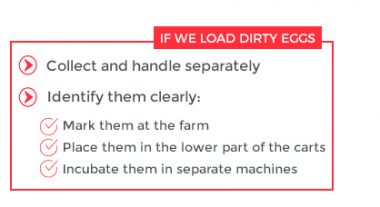
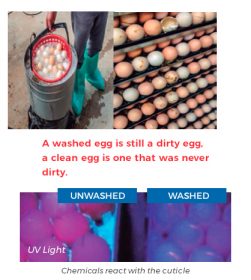
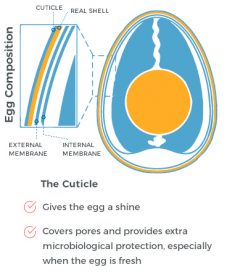
Egg storage
It is a room that must be dedicated solely and exclusively to the storage of the eggs. It must have a storage capacity of several days and air conditioning capacity between 18 and 23 ºC.
SPECIFICS:
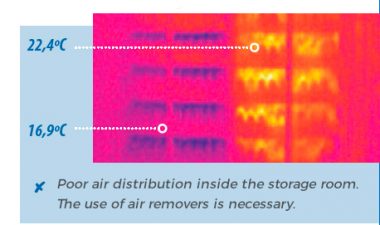
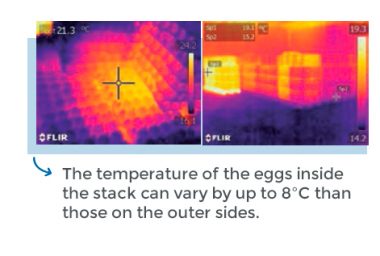
Micro-cracks and fissures
Eggs that have cracked shells or noticeable fissures should not be incubated, since the embryo will die of dehydration. Many times, micro-fissures (hairline cracks) are not detected and these eggs go on to hatch. Of course, the hatchability of these eggs is low and the chicks hatched from them show a mortality up to 4 times more (5-7%) by age 14 days, than those hatched from clean eggs.
In these cases, the weight losses during incubation are greater than in normal circumstances, producing smaller chicks and with higher levels of contamination. These issues may be related to:
We must make checks after each egg handling process and note the number of eggs with micro-cracks or cracks. If the values are too high at any time then we must take measures to reduce them.
Today, the necessary technology is already available to discard these cracked eggs and prevent their incubation.
Transport
The distances between breeder farms and hatchery can vary heavily, but what is certain is, in the vast majority of cases, the method of transport is by truck. Maintaining the same environmental conditions between the truck and the farm’s egg store is important to conserve hatching potential. Normally the temperature of the truck should be the same as that of the farm storage room.
We must avoid bumps between egg carts and strong shaking, trucks must have a good suspension system and fix the carts well inside. The accesses to the farms and incubators must be in the best possible conditions.
We must use temperature recorders during transport to check the temperature fluctuations. Likewise, it would be advisable to measure the external and internal temperature of several eggs from different locations to verify the temperatures.
After transport, the eggs should rest at least 12 hours before starting the incubation. The cleaning and disinfection of all the elements involved in the transport of eggs is of vital importance to avoid the spread of pathogens.
Cooling of freshly loaded eggs should always be avoided, especially if the truck is already loaded with eggs from other farms. When we cool the egg, the volume of the albumin and the yolk is reduced, so the volume of the air chamber increases which allows the entry of outside air (contaminated or not) by suction inside the egg. 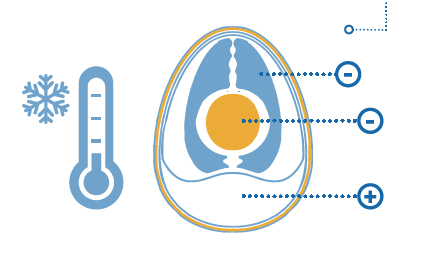
“SWEATING OF EGGS”
It occurs when there are increases in temperature and/or humidity:
If they have sweated, let them dry before:
Egg storage conditions 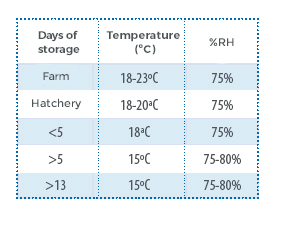
Subscribe now to the poultry technical magazine
AUTHORS

Layer Longevity Starts at Rearing
H&N Technical Team
The Strategy for a Proper Infectious Bronchitis Control
Ceva Technical Team
Elevate Hatchery Performance with Petersime’s New Data-Driven Incubation Support Service
Petersime Technical Team
Maize and Soybean Meal Demand and Supply Situation in Indian Poultry Industry
Ricky Thaper
Production of Formed Injected Smoked Chicken Ham
Leonardo Ortiz Escoto
Antimicrobial Resistance in the Poultry Food Chain and Novel Strategies of Bacterial Control
Edgar O. Oviedo-Rondón
GREG TYLER INTERVIEW
Greg Tyler
Insights from the Inaugural US-RSPE Framework Report
Elena Myhre
Newcastle Disease: Knowing the Virus Better to Make the Best Control Decisions. Part II
Eliana Icochea D’Arrigo
Avian Pathogenic E. coli (APEC): Serotypes and Virulence
Cecilia Rosario Cortés
The Importance of Staff Training on Animal Welfare Issues in Poultry Industry
M. Verónica Jiménez Grez
Rodent Control is a Key Factor in Poultry Biosecurity and Sustainability
Edgar O. Oviedo-Rondón